Agents of Pollination: Vital Ecosystem Intermediaries
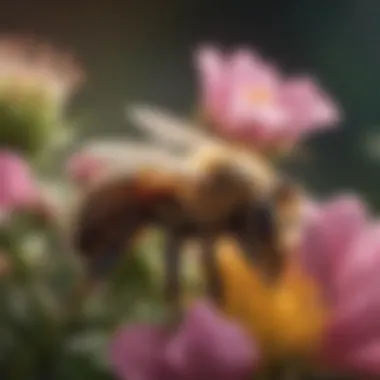
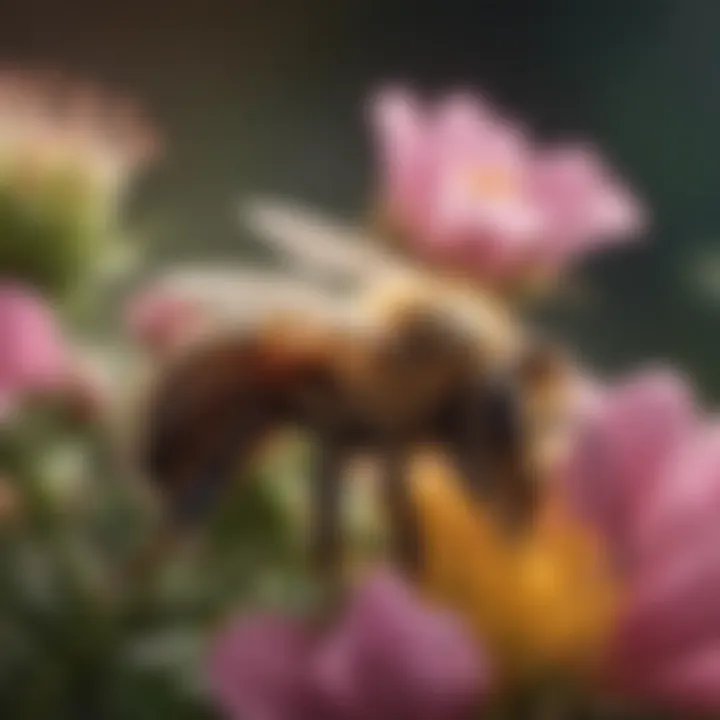
Intro
Pollination serves as a fundamental process in ecological systems, linking plant reproduction to diverse agents that facilitate this vital interaction. The agents of pollination are not merely participants but act as crucial intermediaries that help maintain ecological balance. Understanding their roles is essential as their activities directly influence biodiversity, agricultural outputs, and the health of ecosystems worldwide. In this exploration, the mechanisms and players involved in pollination will be outlined, with a keen focus on their significance in both natural and agricultural landscapes.
Overview of Research Topic
Brief Background and Context
Pollinators, including insects, birds, and mammals, have shaped the evolution of flowering plants over millions of years. The intricate relationships formed through pollination have contributed to the diversity of plant life seen today. As flowering plants depend largely on these agents for reproductive success, their presence is key to sustaining food webs and maintaining the balance of ecosystems.
Recent studies have revealed alarming declines in pollinator populations. Various factors are at play, such as habitat destruction, pesticides, and climate change. The implication of these declines is profound. Without effective pollination, many plant species face the risk of extinction, which could cascade through the ecological network, affecting numerous other species, including humans.
Importance in Current Scientific Landscape
The significance of pollinators transcends mere ecological interest. In agricultural settings, pollinators contribute to the production of fruits, vegetables, and nuts. A study by the Food and Agriculture Organization estimates that pollinators are responsible for 87 of the leading food crops worldwide. This connection to food production emphasizes the urgent need to address their declining numbers and implement conservation strategies.
The current scientific landscape increasingly recognizes the interconnectedness of pollinators, biodiversity, and human livelihoods. Research focusing on pollinator services not only highlights environmental concerns but also aligns with socio-economic interests, advocating for sustainable practices that benefit ecosystems and agricultural systems alike.
Methodology
Research Design and Approach
This article utilizes a comprehensive literature review to synthesize existing research on pollination agents. By systematically analyzing studies from ecological, agricultural, and conservation perspectives, a multifaceted understanding of pollinators' roles is achieved. An interdisciplinary approach enables the examination of pollinators from various angles, including their ecological significance, threats they face, and conservation needs.
Data Collection Techniques
The data collection process involved sourcing information from peer-reviewed journals, government reports, and reputable academic databases. Studies regarding the impact of pesticides, habitat fragmentation, and climate change on pollinator species were especially critical. Additionally, quantitative data regarding pollinator populations and their economic contributions to agriculture provided a reliable basis for discussion.
Prologue to Pollination
Pollination is a fundamental ecological process that greatly impacts the life cycle of flowering plants. By facilitating the transfer of pollen from the male parts of flowers to the female parts, pollination ensures successful fertilization and the production of seeds. This is not only vital for the reproductive success of plants but also plays a crucial role in maintaining the overall health of ecosystems.
Understanding pollination involves looking at various factors that influence this process, such as the types of pollinators involved, the plants that rely on them, and the underlying ecological dynamics. This section serves as a gateway into the complexities of pollination, highlighting its benefits and considerations.
Definition of Pollination
Pollination can be defined as the act of transferring pollen grains from the anther of a flower to the stigma of the same or another flower. Pollen is a fine powder that contains the male gametes for seed production. The key players in this process are pollinators, which can vary widely, including insects, birds, mammals, and even wind and water. Each pollinator has its unique methods and behaviors that contribute to the effectiveness of the pollen transfer.
Pollination can occur in several ways, primarily classified into self-pollination and cross-pollination. In self-pollination, pollen from a flower fertilizes its own ovules. In contrast, cross-pollination involves pollen being transferred to another plant, which enhances genetic diversity and resilience among plant populations.
Significance of Pollination in Ecosystems
The significance of pollination extends far beyond mere plant reproduction. Pollinators form an essential link in the food web, influencing not only the survival of plant species but also the animals that rely on these plants for food. The relationship between plants and their pollinators is often described as mutualistic; while plants provide nectar and pollen as food sources, pollinators ensure the continuation of plant species.
"A single bee can pollinate approximately 1,000 flowers in a single day, highlighting the intense labor that goes into sustaining plant populations."
This dynamic supports biodiversity, as a variety of plant species thrive with the aid of different pollinators. Moreover, many crops that form the basis of human diets—such as apples, almonds, and cherry tomatoes—are also dependent on pollination. Therefore, the ecological significance of pollination cannot be overstated. It is directly tied to food security and the sustainability of agricultural practices worldwide.
Types of Pollinators
Pollinators are essential players in ecosystems. They facilitate the reproduction of many plants by transferring pollen from one flower to another. Various types of pollinators contribute uniquely to this process. Understanding these types allows for a deeper appreciation of their roles and the benefits they bring.
Insects as Pollinators
Insects represent a significant portion of pollinators, contributing to plant reproduction on a massive scale. Different groups of insects specialize in interactions with flowers.
Bees
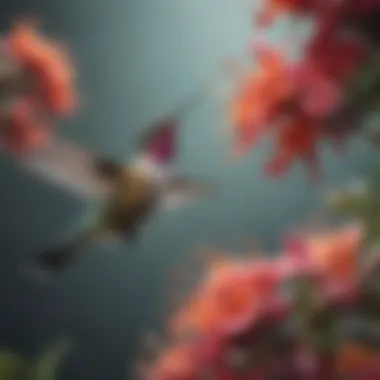
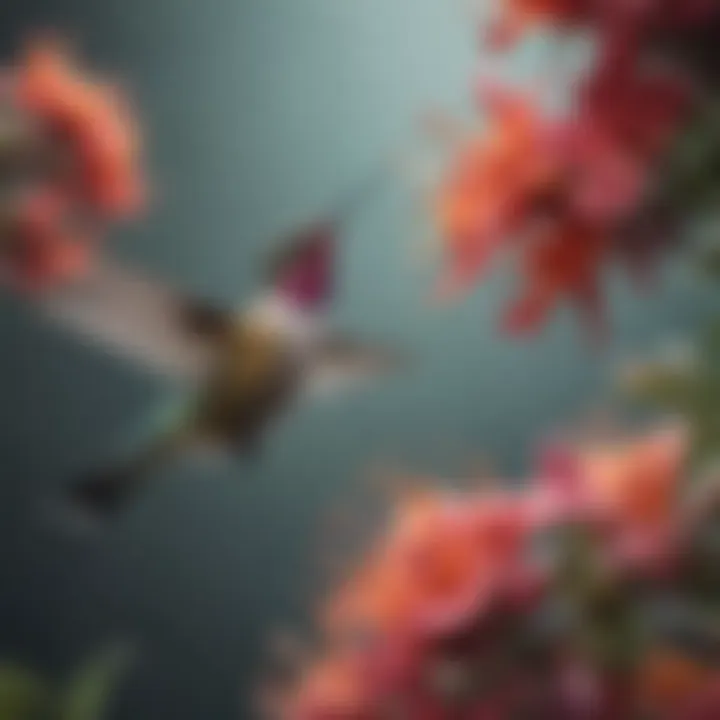
Bees are arguably the most recognized pollinators. Their ability to collect and transfer pollen is critical in many ecosystems, enabling a wide range of flowering plants to reproduce. A notable characteristic of bees is their fuzzy bodies. This feature allows them to gather pollen effectively. They are considered a popular choice for this article due to their high efficiency and specialized behaviors, such as buzzing during pollination, which vibrates flowers and aids in pollen release.
While bees offer numerous advantages, they face threats from habitat loss and pesticide use, impacting their populations.
Butterflies
Butterflies, with their vibrant colors, also play a role in pollination. They are less efficient than bees but contribute to pollination as they flit from flower to flower seeking nectar. A key trait of butterflies is their long proboscis, allowing them to access nectar deep within flowers. This feature makes them beneficial for pollinating plants with tubular flowers.
However, their dependence on specific habitat types can limit their effectiveness in diverse ecosystems.
Moths
Moths, much like butterflies, are nocturnal pollinators. They are attracted to night-blooming flowers primarily emitting strong scents. A specific aspect of moths is their ability to navigate using moonlight, which aids them in locating flowers in the dark. This aspect makes them a unique choice in discussions about pollination.
Nevertheless, moths face challenges, such as declining biodiversity that affects their habitat availability.
Beetles
Beetles are among the oldest pollinators. They have various habits and preferences that contribute to pollination. A notable characteristic of beetles is their broad mouthparts, which allow them to access pollen from many types of flowers. They often consume the reproductive parts of flowers, which can both help and hinder the pollination process.
Despite their efficiency, beetles are often overlooked compared to bees and butterflies, leading to gaps in awareness about their contributions.
Birds and Pollination
Birds are another vital group of pollinators, most prominently represented by hummingbirds and sunbirds. Their adaptations have made them uniquely suited for pollinating specific types of flowers.
Hummingbirds
Hummingbirds are agile fliers, capable of hovering. This ability allows them to feed on nectar without perching. One key characteristic of hummingbirds is their long bills and specialized tongues suited for accessing nectar deep within flowers. Their role in pollination becomes important as they are attracted to bright colors, particularly red.
A disadvantage is their dependency on specific flower types, which can limit their availability in changing environments.
Sunbirds
Sunbirds, mainly found in tropical regions, are similar to hummingbirds as they feed primarily on nectar. Their slender, slightly curved bills are tailored for accessing nectar from tubular flowers. This specific feature facilitates mutualistic relationships with certain plant species. Like hummingbirds, their reliance on certain blooms makes them vulnerable amid habitat destruction.
Mammals in the Pollination Process
In addition to insects and birds, some mammals also contribute to pollination, notably bats and certain rodents.
Bats
Bats are significant pollinators in various ecosystems, particularly for flowers that bloom at night. Their echolocation ability allows them to navigate and locate flowers in the dark. This unique aspect offers an advantage for nighttime pollination. Many fruit and flower species depend on bats for successful reproduction.
Nevertheless, their populations are often affected by habitat loss and disease.
Fruits and Rodents
Some small mammals like rodents can also aid in pollination. They often consume fruits and, while doing so, disperse seeds, which can contribute to plant propagation. A key trait of these mammals is their positioning in the food web, linking plant reproduction with larger ecosystem dynamics. Their role, however, varies significantly based on species and ecological context.
Water as a Pollination Medium
Pollination through water is less common, yet it plays a role in specific ecosystems. Some aquatic plants utilize water currents to facilitate pollen transport between blooms. This unique method underscores the diverse strategies plants and organisms use for reproduction. The effectiveness of water-based pollination can vary widely based on environmental conditions and plant species.
Pollinator Preferences and Behavior
Understanding pollinator preferences and behavior is essential in the exploration of ecosystem dynamics. Pollinators exhibit specific inclinations towards particular flowers due to various factors such as flower morphology, nectar availability, and color. This relationship is not incidental but crucial for both the survival of pollinators and the reproductive success of plants. By examining these behaviors, we can gather significant insights into ecosystem functions and health.
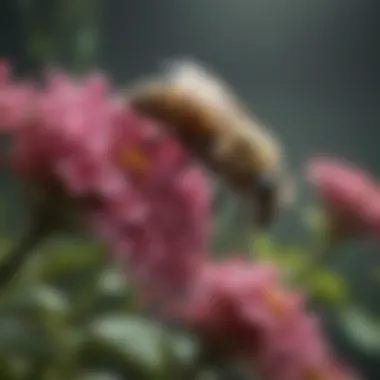
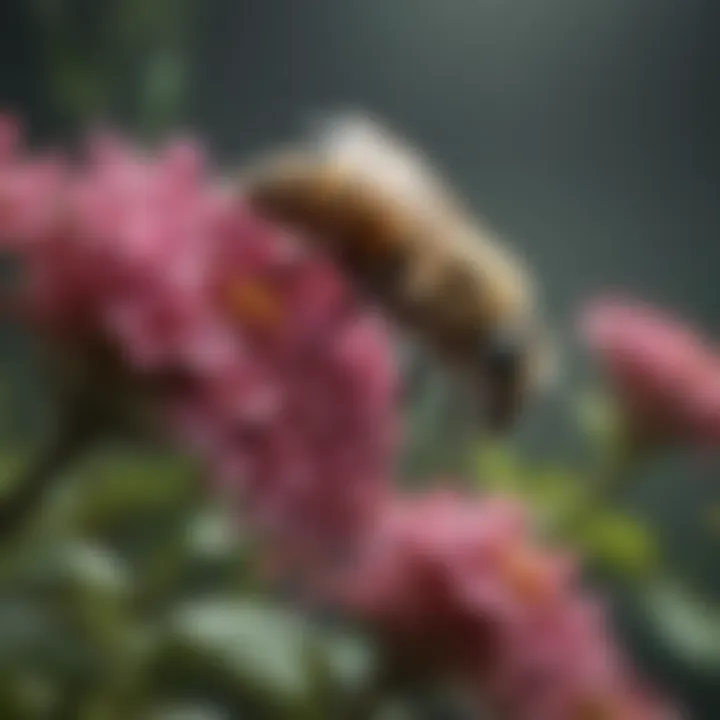
Flower Morphology and Pollinator Attraction
Flower morphology plays a vital role in attracting specific pollinators. The shape, size, color, and scent of flowers are tailored to appeal to their preferred pollinators. For example, bright colors such as yellow and blue significantly attract bees, while tubular flowers may be favored by hummingbirds. Each pollinator type has unique physical adaptations that enhance the efficiency of pollen transfer.
Certain floral traits serve as signals. These include:
- Shape: Some flowers are designed to fit the body of a specific pollinator, ensuring that while accessing nectar, the pollinator also comes into contact with the reproductive parts of the flower.
- Size: Larger flowers may accommodate larger pollinators, while smaller flowers can attract those that are more diminutive.
- Color: The color spectrum caters to different visual systems. For example, bees are attracted to UV patterns often invisible to the naked eye of humans.
- Scent: Many flowers emit specific scents to attract nocturnal pollinators like moths, indicating that olfactory cues are just as vital as visual ones.
This mutual adaptation fosters a symbiotic relationship that benefits both plants and pollinators, ensuring successful reproduction and food sources.
Temporal Activity Patterns of Pollinators
The activity patterns of pollinators throughout different times of the day can significantly influence their interactions with flowers. Some species are more active during particular periods, dictated by factors like light availability, temperature, and the presence of other forage sources.
For example:
- Diurnal Pollinators: Many bees and butterflies are most active during daylight hours. This temporal niche allows them to maximize their foraging efficiency during peak flower availability.
- Nocturnal Pollinators: Other species, such as certain moths, thrive at night. Their interactions with specific flowers that bloom after dusk help to maintain pollination even when diurnal pollinators are inactive.
Understanding these patterns is critical for optimizing agricultural practices and conserving habitats. By aligning cultivation and conservation efforts with the activity patterns of pollinators, we can enhance pollination services and, consequently, the productivity of crops and the stability of ecosystems.
"Pollinator behaviors are interlinked with their preferences, framing a complex web of interactions that shapes ecosystems."
Pollinator preferences and behavior ultimately highlight the intricacies of floral-pollinator relationships. These relationships inform broader ecological dynamics, emphasizing the need for informed conservation strategies.
The Role of Pollination in Agriculture
Pollination plays a pivotal role in agriculture and is essential for the production of many crops. It directly impacts food security and the economy by influencing the yield and quality of fruit and vegetable harvests. Without effective pollination, many plants cannot reproduce. This process is vital not only for individual farmers but also for entire communities that rely on agricultural products.
An array of animals, including bees, birds, bats, and other insects, facilitate the transfer of pollen between flowering plants. These agents of pollination significantly increase the output of several key crops. For instance, crops such as almonds, apples, and pumpkin are heavily dependent on these natural services. Their existence ensures that we have variety in food production, which is crucial for nutrition and health.
Economic Value of Crop Pollination
The economic impact of crop pollination is immense. It is estimated that pollinators contribute to the production of fruits, vegetables, and nuts valued at over $150 billion annually in the United States alone. This figure highlights the direct financial advantage that farmers gain when pollinators are present.
- Pollination increases not only the quantity but also the quality of produce.
- Higher quality yields can lead to better market prices.
- Diverse pollinators can benefit different crops, leading to a wider variety of agricultural products available.
Farmers may face considerable losses if pollinators disappear, as certain crops show dramatically reduced yields without them. For example, the lack of sufficient pollination can reduce berry crops by up to 90%. Thus, understanding this economic value leads to better support for conservation efforts.
Pollination Services and Ecosystem Benefits
Pollination services extend beyond agriculture. They enhance biodiversity and ecosystem health. Healthy ecosystems are also more resilient against pests and diseases, reducing the need for chemical interventions.
- Many pollinator species help maintain the variety of plant life, which supports other wildlife.
- Plants that rely on animal pollinators often produce seeds that are more viable, contributing to stable populations.
- The presence of diverse pollinators can improve the yield of crops, leading to a synergistic effect on ecosystem productivity.
In sum, pollination is an integral component in agriculture. It not only supports economic stability but also contributes to a thriving environment, which is incredibly necessary in today’s changing world.
"Effective pollination is essential for food production, and neglecting this service endangers our entire food system."
Threats to Pollinator Populations
Pollinators are essential for maintaining ecological balance. Yet, their populations face various threats that jeopardize their survival and, consequently, the health of ecosystems. Understanding these threats is critical not only for conservation efforts but also for the future of agriculture and biodiversity. The impacts of declining pollinator populations extend beyond individual species; they affect entire ecosystems, food production, and economic stability.
Habitat Loss and Fragmentation
The foremost threat to pollinators is habitat loss. Urban expansion, agricultural development, and infrastructural projects contribute significantly to this issue. Natural habitats are replaced with buildings and monoculture crops. This alteration reduces the availability of food and nesting sites for many pollinators. Additionally, fragmentation leads to isolated populations that cannot interbreed, reducing genetic diversity and resilience.
In areas where ecosystems are fragmented, it becomes challenging for pollinators to navigate. Species such as bees require diverse floral structures to thrive. A lack of diverse flora can result in inadequate nutrition, affecting their health and pollination effectiveness.
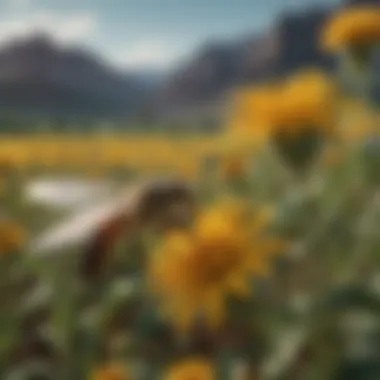

Pesticides and Chemical Exposure
The use of pesticides is another critical factor contributing to pollinator decline. Chemicals used in agriculture, such as neonicotinoids, can have lethal effects on insects. Even sub-lethal exposure can impair pollinators' foraging abilities, navigation skills, and reproductive success.
Research indicates that pesticides not only kill pollinators outright but also disrupt their natural behaviors. The timing of pesticide application, usually during peak pollinator activity, adds to this vulnerability. Effective regulation of pesticide use, alongside integrated pest management practices, is essential to protect these vital species.
Climate Change and its Impact
Climate change presents a wide array of challenges for pollinator populations. Shifting weather patterns affect flowering times and the distribution of both plants and pollinators. As temperatures rise, some species may be forced to migrate to cooler areas. However, not all pollinators can adapt quickly, putting them at risk of extinction.
Additionally, extreme weather events such as droughts and floods disrupt ecosystems, diminishing food sources for pollinators. The interdependence between plants and their pollinators means that any changes can have cascading effects throughout the ecosystem.
"Loss of pollinator populations can lead to a decline in plant diversity and ultimately affect entire ecosystems."
In summary, threats to pollinators stem from multiple sources including habitat loss, pesticide usage, and climate change. Protecting these species is essential. Understanding these threats will help guide effective conservation strategies. The future of pollinators directly impacts human food systems and broader ecological health.
Conservation Strategies for Pollinators
The decline of pollinator populations has become a significant environmental concern. The importance of conservation strategies for pollinators cannot be overstated. These strategies play a vital role in sustaining biodiversity, ensuring food security, and maintaining the health of ecosystems. Effective conservation measures address various aspects, including habitat preservation, agricultural practices, and community engagement.
Pollinators contribute to the reproduction of more than 75% of flowering plants. Their decline can lead to reduced crop yields, lost biodiversity, and ecological imbalance. Implementing targeted conservation strategies helps mitigate these risks while also protecting pollinator habitats.
Habitat Restoration Initiatives
Habitat restoration initiatives focus on improving and rehabilitating environments where pollinators can thrive. This involves the reintroduction of native plant species, which provide food and nesting areas for various pollinators.
A few critical actions include:
- Increasing native flora: Planting wildflowers and native plants encourages diverse pollinator species. Certain plants attract specific pollinators, improving reproductive rates.
- Creating buffer zones: Establishing buffer zones around agricultural areas helps protect pollinator habitats from pesticides and habitat loss.
- Restoration of wetlands: Pollinators often rely on wetland plants for food. Restoring these areas supports not only pollinators but also numerous other species.
Local communities can play an active role in these initiatives by engaging in planting native species in public spaces and gardens, thereby contributing to biodiversity recovery.
Sustainable Agricultural Practices
Sustainable agricultural practices are vital for protecting pollinators. They emphasize minimizing harmful impacts on the environment while ensuring agricultural productivity. Here are essential practices:
- Integrated pest management (IPM): This approach reduces the reliance on chemical pesticides, opting instead for biological control methods that are less harmful to pollinators.
- Crop rotation and polyculture: By planting a variety of crops, farmers can create a more stable habitat for pollinators and improve soil health. This variety also encourages a wider range of pollinators.
- Cover crops: These crops improve soil quality and offer additional forage for pollinators.
Adopting sustainable practices not only supports pollinator health but also promotes long-term agricultural viability. Farmers who embrace these strategies might also find economic benefits, as healthy pollinator populations lead to better crop yields.
"By prioritizing conservation strategies, we pave the way for a healthier ecosystem and ensure food security for future generations."
In summary, conservation strategies for pollinators are essential for recovering and sustaining these critical ecosystem agents. Habitat restoration and sustainable agriculture are two primary avenues through which we can make a difference. Future efforts must focus on collaboration among scientists, farmers, and communities to ensure successful implementation and monitoring of these initiatives.
Future Directions in Pollination Research
Research in pollination is crucial for understanding and preserving our ecosystems. As the dynamics of our planet change, the agents of pollination face unprecedented challenges. Future directions in this research area will focus on several key elements, all crucial for sustaining the delicate balance of our environments.
Technological Innovations in Pollinator Studies
Technological advancements are reshaping how we study pollinators. Tools like drones, environmental sensors, and genetic sequencing facilitate observations and data collection. For instance, drones can survey vast areas to monitor pollinator populations and their activity patterns. This allows researchers to gather data over larger scales than traditional methods permit.
Furthermore, environmental sensors can track climate variables such as temperature and humidity. Understanding how these changes affect pollinators is critical. Genetic sequencing helps reveal the biodiversity within pollinator species, shedding light on their evolutionary adaptations. These technological innovations enable more accurate analyses of pollinator health and behavior, providing valuable insights that were previously unattainable.
"Embracing technology in pollinator studies can uncover solutions that were once obscured by conventional methods."
Integrating Pollinator Health into Ecosystem Management
Integrating pollinator health into ecosystem management is essential for sustaining biodiversity and ecosystems. This involves a holistic approach where conservation efforts consider the specific needs and challenges faced by pollinating species. Pollinators serve as vital indicators of environmental health; thus, their well-being reflects the overall condition of ecosystems.
Effective management strategies need to include:
- Monitoring Pollinator Populations: Regular assessments of pollinator health can identify trends and inform timely interventions.
- Habitat Protection: Preserving diverse habitats is crucial for ensuring that pollinators have the resources they need, such as food and nesting sites.
- Collaboration Across Sectors: Integrating insights from agriculture, urban development, and conservation can foster practices that support pollinators.
By prioritizing pollinator health within broader ecological management frameworks, we create a more resilient environment. Understanding and protecting these crucial agents of pollination will enhance ecosystem function and services, benefiting both wildlife and human agriculture.



